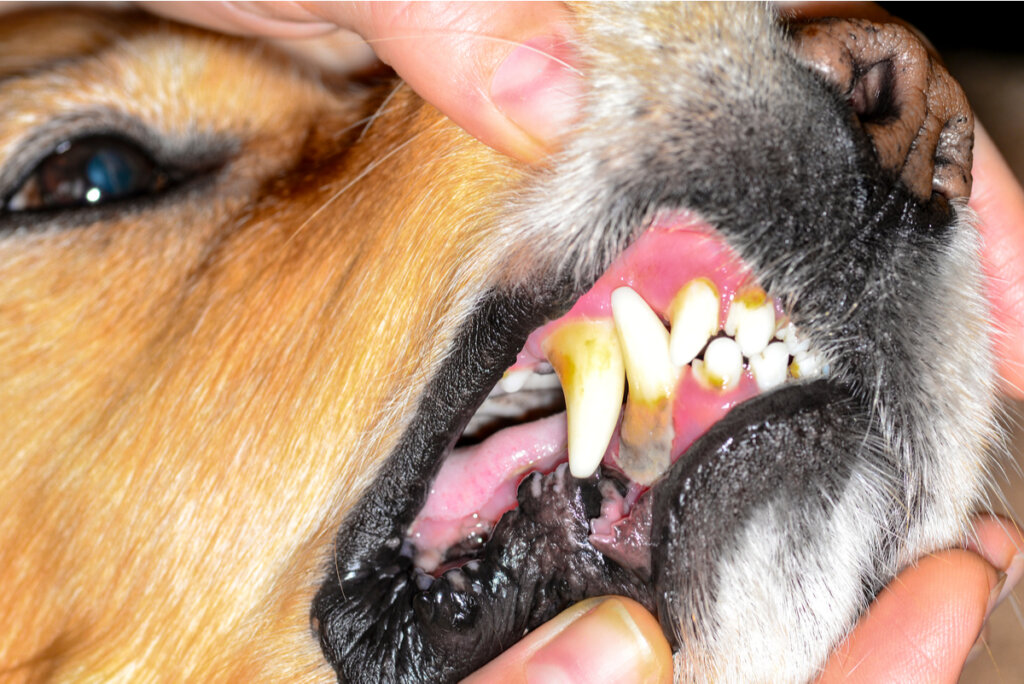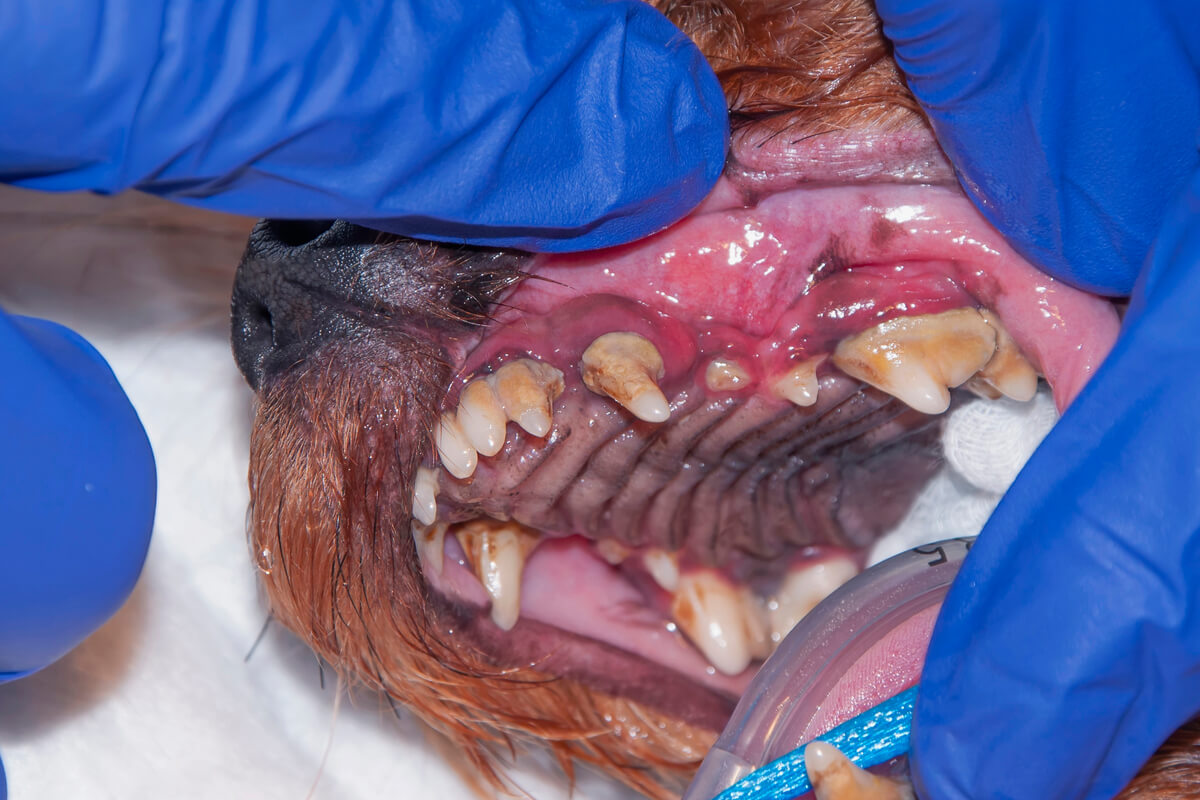What Are the Causes of Stomatitis in Dogs?

Stomatitis in dogs is an inflammatory pathology that affects oral health. Strange as it may seem, this disease occurs more frequently in cats than in dogs.
In fact, sometimes dog owners may confuse stomatitis with gingivitis, since both conditions can manifest in a similar way. Here we’ll tell you everything you need to know about stomatitis in dogs.
What features characterize stomatitis in dogs?
One feature to note is that stomatitis doesn’t affect the supporting tissues that attach the tooth to the dog’s jaw cavity. These are, for example, the alveolar bones, portions of the jawbone that surround and contain the tooth sockets. Neither does it affect the periodontal ligaments.
In general, stomatitis damages soft and fleshy structures. For example, the pharynx, the oral mucosa, the inside of the cheeks and the tongue, although it can also affect the gums. Typically, stomatitis manifests with the formation of painful and persistent ulcers.
What causes stomatitis?
Stomatitis causes general inflammation of the oral mucosa, which may or may not include the gums and tongue. Although the origin of this pathology is still unknown, several situations can lead to its appearance, among which are the following:
- Oral lacerations: wounds in the mouth can cause bacteria to enter and produce a generalized inflammation of the oral mucosa.
- Periodontal disease: this pathology chronically affects the stability of both the gums and the buccal mucosa, which could lead to the appearance of stomatitis.
- Oral infections: various fungi and bacteria can invade the oral mucosa and cause stomatitis. This usually happens due to immune problems in dogs.
- Nutritional deficiencies: the lack of vitamins or nutrients could lead to the presence of inflammatory or infectious pathologies in the oral mucosa. This makes stomatitis more likely to appear.
- Genetic diseases: although it’s still unknown how genes could induce the presence of stomatitis, it has been observed that certain breeds are more prone to suffer from it.
- Neoplasms: several types of tumors are capable of generating generalized inflammation in different areas of the mouth, which could also lead to chronic stomatitis.
- Foreign bodies in the mouth: in a dog’s mouth there are several folds of skin that aren’t so obvious. However, they’re large enough for some small objects to get stuck between them, leading to infections, lacerations, and, in severe cases stomatitis.
- Poor oral hygiene: Dogs’ dental plaque is made up of bacterial colonies capable of causing infections. If oral hygiene isn’t taken care of, these bacteria could cause cases of chronic stomatitis.
Stomatitis may be a primary condition
Primary diseases are those that appear without apparent cause. In primary generalized stomatitis the buccal mucosa is affected and often the margins of the tongue and the mucosa surrounding the teeth. However, no specific cause is detected.
Stomatitis, as a primary condition, is associated with an exaggerated host immune response to oral microbes that form dental plaque. It’s more common for generalized stomatitis to occur as a consequence of a variety of other diseases, i.e., as a secondary condition.
Stomatitis in dogs as a secondary condition
Many medical conditions, which are defined as underlying causes, can lead to the development of stomatitis in canines. These are some of them:
- Autoimmune disorders
- Bacterial, parasitic, or fungal infections
- Contact with caustic substances or reaction to certain medications
- Hormonal deficiencies
- Other diseases such as diabetes, lymphoma, kidney disease, osteomyelitis and hypereosinophilic syndrome
The symptoms of stomatitis
As we mentioned earlier, some symptoms of stomatitis are very similar to those of gingivitis. Usually, the only way to achieve a definitive and correct diagnosis is through a veterinary examination.
To understand when a visit to the veterinary clinic is necessary, it’s important to be aware of the appearance of any of the following symptoms:
- Appearance of ulcers on the cheeks, gums or tongue that sometimes ooze pus.
- Bad breath, accompanied by bleeding gums and excessive drooling.
- Reddened and inflamed lesions.
In addition, it’s common to observe reluctance or difficulty eating, with associated weight loss. Mouth lesions often cause the dog to show reluctance to groom.
Diagnosis of stomatitis in dogs
Due to the close similarity of stomatitis to gingivitis, the main diagnostic tool is the dog’s medical history. With this, the presence of secondary diseases or adverse reactions to certain drugs are ruled out. However, it isn’t enough to have an accurate diagnosis.
In addition to the clinical history, the veterinarian should perform a physical examination to check for damage to the oral mucosa. X-rays may also be necessary to verify the severity of the pathology. Depending on what the professional considers, it’s also possible to take cultures or biopsies of the buccal mucosa, with the aim of confirming the presence of infectious pathogens.
Different types of stomatitis
Once the diagnosis has been clarified, it’s important to classify what type of stomatitis the dog has. In this way, the treatment can be directed to eliminate the causes that originate the condition and improve the pet’s quality of life. According to the origin of the stomatitis, it’s classified as follows:
- Ulcerative stomatitis: This is usually the result of an exaggerated immune response to bacteria. It’s usually chronic, although in more severe cases it’s also called necrotizing ulcerative stomatitis.
- Immune-mediated ulcerative gingivostomatitis: Caused by periodontal disease. Apart from the presence of stomatitis, this pathology is characterized by symptoms of gingivitis and generalized inflammation of the oral mucous membranes.
- Lymphoplasmacytic gingivostomatitis: This is quite rare in dogs, so the causes of its occurrence are unknown. It’s possible that it’s related to an immunological problem, although there’s little basis for this.
Are some breeds or stages of canine growth more susceptible to stomatitis?
It’s important to keep in mind that any breed can develop stomatitis. However, some canine breeds have a certain predisposition to medical conditions that often include stomatitis as a side effect.
So, for example, osteomyelitis is more common in some breeds, especially spaniels, greyhounds, Labradors, Maltese and miniature Schnauzers.
On the other hand, hypereosinophilic syndrome is common in Alaskan malamutes and Cavalier King Charles spaniels. It’s also more present in German Shepherds, Italian Greyhounds, Rottweilers and Siberian Eskimo dogs.
Although a dog can be exposed to this oral condition at any age, in puppies the inflammation may be associated with teeth crowding in the mouth.
How is this disease treated?
Treatment of stomatitis in dogs is often difficult and at other times the condition may go away on its own, once the underlying cause is treated. This is true in cases of infection or exposure to caustic chemicals.
It’s also common to perform different rinses with disinfectant solutions in the mouth, in order to reduce the amount of plaque and pathogens. Also, the use of antibiotics and antifungals might be necessary, although this depends entirely on the professional’s indications.
In general, veterinarians will try to preserve the teeth, however, they often have to extract them. This is done in order to reduce pain and improve the animal’s quality of life.
Treatments with immunosuppressive drugs or steroids can reduce inflammation, but have side effects, especially with long-term treatments. For this reason, they’re often among the last options proposed by professionals.

Final recommendations
Daily dental hygiene and regular professional cleanings can slow the progression of stomatitis, but this is often not enough to prevent pain. Also, be aware that dogs who have had teeth extracted may need a soft food diet.
As always, prevention is the best strategy to protect your dog from this painful disease and many other oral conditions. So be sure to have frequent checkups with your veterinarian to confirm that all is well. Also, consider checking your dog’s body frequently. In case of any anomaly, don’t hesitate to contact a professional as soon as possible.
All cited sources were thoroughly reviewed by our team to ensure their quality, reliability, currency, and validity. The bibliography of this article was considered reliable and of academic or scientific accuracy.
- Anderson, J. G., Peralta, S., Kol, A., Kass, P. H., & Murphy, B. (2017). Clinical and Histopathologic Characterization of Canine Chronic Ulcerative Stomatitis. Veterinary pathology, 54(3), 511–519. https://doi.org/10.1177/0300985816688754
- Lyon KF. (2005). Gingivostomatitis. Vet Clin North Am Small Anim Pract. Jul;35(4):891-911, vii. doi: 10.1016/j.cvsm.2005.02.001. PMID: 15979518. https://pubmed.ncbi.nlm.nih.gov/15979518/
- Sánchez, M. Farias, P. & Martínez, S. (2018) Enfermedades odontológicas en los animales de compañía: profilaxis, diagnósticos y tratamientos (Tesis de grado, Universidad Nacional del Centro de la Provincia de Buenos Aires). https://www.ridaa.unicen.edu.ar/xmlui/bitstream/handle/123456789/1923/SANCHEZ,%20MARTIN.pdf?sequence=1&isAllowed=y
- Thiverge, G. (1973). Granular stomatitis in dogs due to Burdock. The Canadian Veterinary Journal, 14(4), 96.
- Jadhav, V. J., & Pal, M. (2006). Estomatitis en perros por Candida albicans. Revista iberoamericana de micología, 23(4), 233-234.
- Villela, P. A., de Souza, N. D. C., Baia, J. D., Gioso, M. A., Aranha, A. C. C., & de Freitas, P. M. (2017). Antimicrobial photodynamic therapy (aPDT) and photobiomodulation (PBM–660 nm) in a dog with chronic gingivostomatitis. Photodiagnosis and Photodynamic Therapy, 20, 273-275.
